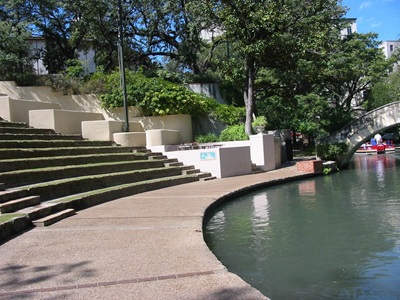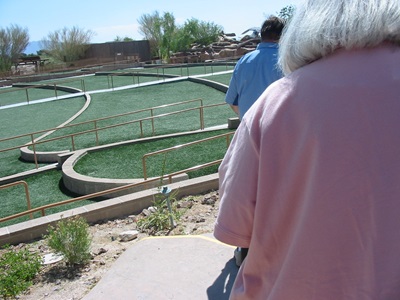Community Amphitheaters Can Be Viable Low-Budget Projects with Big Benefits
Published: June 15, 2024
Community amphitheaters are even more important as places of community gathering and social interaction than as beautification. After all, a gentle grassy slope already may be quite pretty. But both the social capital and the beautification goals are potentially important in different situations.
A visitor to a predecessor website had sent us some photos of amphitheaters she liked and was considering for her own community. I have obtained permission to use these photos, although by now I have visited all of these places personally and can verify that they are satisfying examples of different styles you could adapt to your own environment.
You can make a splash by changing some forsaken slope or low spot into an amphitheater. The value proposition of the amphitheater is that it is an interesting but possibly inexpensive gathering space. If the natural topography already is working in your favor, you will not have the expense of excavating and grading.
Alternatively, you may just need a pretty meeting place with sloped seating for great visibility.
Here is a photo of an amphitheater at President George H.W.
Bush’s Library in College Station, Texas. This example is used for tourist
seating for ranger talks.

Some others are used mostly for music or maybe even live theatre performances. For example, the Arneson River theater in San Antonio consists of concrete or rock steps with little strips of grass that people would sit on. This arrangement offers durability in the face of a lot of use, but then keeping the grass under control, presumably with a weed whacker gadget, would seem to be a maintenance challenge. For concerts or performances of any type, the uniform spacing of the rows would seem to offer a certain amount of order and accommodate more people, no doubt.
There are similar examples around the country. The first photo below shows the detail, while the second one below gives a good overview of the setting.


It seems like in some of the places I have visited, the amphitheater are very shallow. Below is an example from Indianapolis that is mostly just grass by the White River bank.

As a last resort, you can create an artificial turf amphitheater. The example below, from Las Vegas, features very wide steps between the levels, with the curved steps. For a place where water is at a premium, such as Las Vegas, we find the plastic grass to be acceptable.

Some Considerations about Maintaining and Running an
Amphitheater
If you are going to build the amphitheater with volunteer labor, you probably will not have any paid staff responsible for maintenance either. This means you really need to design your amphitheater to be as low-maintenance as possible. It looks like the grass strips at the Bush Library are wide enough to machine mow, and that would make them easier to maintain than the Arneson River Theater at La Villita in San Antonio.
Consider carefully who is to “own” the amphitheater, if that is not self-evident. If you need to create a new entity, which might happen if you are using a vacant lot or series of lots, consider ownership by a local government or a prominent and well-established community organization. Someone must take reservations for events, which might include festivals, demonstrations, local concerts, theatre, talks, children’s educational activities, both public and private celebrations, art shows, and more. Someone must take bookings and collect fees, if any are to be charged.
If you decide to leave the amphitheater in its natural shape with turf grass, you may want some landscaping around the edges to define the space and provide additional beauty. After all, I think most amphitheaters should provide beautification as well as a gathering space.
- Making and Keeping a Good Community ›
- Community Improvement Projects › Community Amphitheaters
Join GOOD COMMUNITY PLUS, which provides you monthly with short features or tips about timely topics for neighborhoods, towns and cities, community organizations, and rural or small town environments. Unsubscribe any time. Give it a try.
